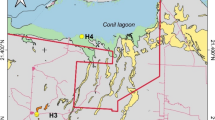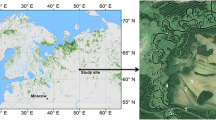Abstract
The importance of pore water chemistry for the peatland vegetation was closely examined in Ozegahara mire, Japan. Along a transect from a riverside to the center of mire, dominant vegetation changed in an almost decreasing order of plant height: gallery forest, skunk cabbage, reed, sasa-bamboo, Moliniopsis japonica, and sphagnum, with sporadic appearance of cinnamon fern (Osmunda cinnamomea) with heights of around 100 cm along the way. It was found that these vegetations had different (Ca2+ + Mg2+) concentration in peat interstitial waters and ash content in peat, respectively (p < 0.05), suggesting a close association of the vegetation types with each physicochemical environment. Most of the sites along the transect were found to be ombrotrophic, on the basis of the groundwater tables much higher than the river surface (up to 6.0 m) and SiO2 concentrations in peat interstitial waters (2.4 ± 0.9 mg/L) that were only around one-tenth of that in the river. Nevertheless, the analysis of ash content in peat demonstrated that soil particles had been transported through river overflows to the mire, especially in the cinnamon fern sites, which had ash contents more than 50% in deeper layers (15–20 cm and 20–25 cm). It was found that SiO2, Ca2+, Mg2+, and K+ concentrations in peat interstitial waters were significantly correlated with fine-sand contents in peat sampled at 5–10 cm depth (p < 0.05). In addition, plant heights showed significant positive correlations with both K+ and Ca2+ concentrations (p < 0.05). The results suggest that, in this mire where is mostly ombrotrophic, soil particles derived from flooding would serve as an important mineral source to affect the vegetation type.














Similar content being viewed by others
References
Arsenault J, Talbot J, Moore TR, Beauvais MP, Franssen J, Roulet NT (2019) The spatial heterogeneity of vegetation, hydrology and water chemistry in a peatland with open-water pools. Ecosystems 22:1352–1367
Bourbonniere RA (2009) Review of water chemistry research in natural and disturbed peatlands. Can Water Resour J 34:393–414
Bragazza L, Gerdol R (2002) Are nutrient availability and acidity-alkalinity gradients related in Sphagnum-dominated peatlands? J Veg Sci 13:473–482
Bridgham SD, Pastor J, Janssens JA, Chapn C, Malterer TJ (1996) Multiple limiting gradients in peatlands: a call for a new paradigm. Wetlands 16:45–65
Chapin F, Barsdate R, Barèl D (1978) Phosphorus cycling in alaskan coastal tundra: a hypothesis for the regulation of nutrient cycling. Oikos 31:189–199
Damman AWH (1988) Regulation of nitrogen removal and retention in sphagnum bogs and other peatlands. Oikos 51:291–305
Elser JJ, Bracken MES, Cleland EE, Gruner ES, Harpole WS, Hillebrand H, Ngai JT, Seabloom EW, Shurin JB, Smith JE (2007) Global analysis of nitrogen and phosphorus limitation of primary producers in freshwater, marine and terrestrial ecosystems. Ecol Lett 10:1135–1142
Encyclopedia of measurement and analysis on global environment (2003) Takeuchi H ed., Fuji Technosystem
Glina B, Piernik A, Hulisz P, Mendyk Ł, Tomaszewska K, Podlaska M, Bogacz A, Spychalski W (2019) Water or soil—What is the dominant driver controlling the vegetation pattern of degraded shallow mountain peatlands? Land Degrad Dev 30:1437–1448
Griffiths NA, Sebestyen SD, Oleheiser KC (2019) Variation in peatland porewater chemistry over time and space along a bog to fen gradient. Sci Total Environ 697:134152
Hájek M, Plesková Z, Syrovátka V, Peterka T, Laburdová J, Kintrová K, Jiroušek M, Hájek T (2014) Patterns in moss element concentrations in fens across species, habitats, and regions. Perspect Plant Ecol Evol Syst 16:203–218
Hájková P, Hájek M (2004) Bryophyte and vascular plant response to base-rich and water level gradients in Western Carpathian Sphagnum rich mires. Folia Geobot 39:335–351
Harbert BL, Cooper DJ (2017) Environmental drivers of subalpine and alpine fen vegetation in the Southern Rocky Mountains, Colorado, USA. Plant Ecol 218:885–898
Hogetsu K, Ichimura S, Hori S, Oshima Y, Kasahara H, Ono K, Takada K (1954) Plant ecological study of Ozegahara mire. Ozegahara, pp 313–397
Hori S (1975) Exploring Ozegahara mire - Its origin and vegetation. Tsukiji Shokan Publishing ((in Japanese))
Howie S, van Meerveld H (2013) Regional and local patterns in depth to water table, hydrochemistry and peat properties of bogs and their laggs in coastal British Columbia. Hydrol Earth Syst Sci 17:3421–3435
Lemly J, Cooper D (2011) Multiscale factors control community and species distribution in mountain peatlands. Botany 713:689–713
Mitsch WJ, Gosselink JG (2000) Wetlands -, 3rd edn. John Wiley & Sons
Mitsch WJ, Gosselink JG (2015) Wetlands –, 5th edn. John Wiley & Sons
Moore PD, Bellamy DJ (1974) Peatlands. Springer-Verlag, p 221
Nakamura T, Uemura S, Yabe K (2002) Hydrochemical regime of fen and bog in north Japanese mires as an influence on habitat and above-ground biomass of Carex species. J Ecol 90:1017–1023
Økland RH, Økland T, Rydgren K (2001) A Scandinavian perspective on ecological gradients in north-west European mires. J Ecol 89:481–486
Oze Preservation Foundation (2018) Report of Oze preservation in 2017 (in Japanese)
Reynolds B, Stevens PA, Hughes S, Brittain SA (2004) Comparison of field techniques for sampling solution in upland peatland. Soil Use Manag 20:454–456
Sakaguchi Y (1982) The origin of ozegahara basin and the development of mire. Biol Chem 34:36–43 ((in Japanese))
Sakaguchi (1989) Natural history of Ozegahara – Exploring the secret of landscape. Chuko Shinsho Chuokouron Shinsha ((in Japanese))
Sjörs H (1950) On the relation between vegetation and electrolytes in North Swedish mire waters. Oikos 2:241–258
Sjörs H, Gunnarsson U (2002) Calcium and pH in north and central Swedish mire waters. J Ecol 90:650–657
Tahvanainen T (2004) Water chemistry of mires in relation to the poor-rich vegetation gradient and contrasting geochemical zones of the northeastern Fennoscandian Shield. Folia Geobot 39:353–369
Tahvanainen T, Sallantaus T, Heikkiljä R, Tolonen K (2002) Spatial variation of mire surface water chemistry and vegetation in northeastern Finland. Ann Bot Fenn 39:235–251
Venterink O, van der Vliet H, Wassen M (2001) Nutrient limitation along a productivity gradient in wet meadows. Plant Soil 234:171–179
Vitt DH, Chee WL (1990) The relationships of vegetation to surface water chemistry and peat chemistry in fens of Alberta, Canada. Vegetatio 89:87–106
Vitt DH, Bayley SE, Jin TL (1995) Seasonal variation in water chemistry over a bog-rich fen gradient in continental western Canada. Can J Fish Aquat Sci 52:587–606
Wheeler BD, Proctor MCF (2000) Ecological gradients, subdivisions and terminology of north-west European mires. J Ecol 88:187–203
Wolf EC, Cooper DJ (2015) Fens of the Sierra Nevada, California, USA: patterns of distribution and vegetation. Mires Peat 15:1–22
Yamagata N (1954) Study of Ozegahara from a viewpoint of earth science. Ozegahara, pp 134–146 ((in Japanese))
Acknowledgements
We are deeply grateful for Mr./Ms. Y. Tashiro, C. Tokunaga, D. Fukumoto, K. Nagata, Y. Tateishi, Y. Takagai, S. Morita, A. Sonohara, R. Tsuneoka, and S. Fan for their devoted helps for the field samplings. We also thank Prof. Y. Umezawa for valuable discussion, Prof. M. Watanabe for a technical guidance, and Prof. T. Gomi for enabling us the particle-size distribution analysis. This research was conducted as a part of activities of the fourth comprehensive Oze Academic Research.
Author information
Authors and Affiliations
Corresponding author
Additional information
Publisher's Note
Springer Nature remains neutral with regard to jurisdictional claims in published maps and institutional affiliations.
Handling Editor: Ryuichiro Shinohara.
Supplementary Information
Below is the link to the electronic supplementary material.
Rights and permissions
About this article
Cite this article
Murakami, H., Yoh, M. Interstitial water chemistry and soil particles determine vegetation in Ozegahara Mire, Japan. Limnology 23, 195–205 (2022). https://doi.org/10.1007/s10201-021-00682-y
Received:
Accepted:
Published:
Issue Date:
DOI: https://doi.org/10.1007/s10201-021-00682-y




